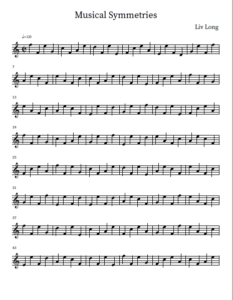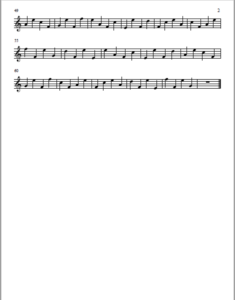All polygons can be transformed a different number of times. Squares can be turned 90º four times to reach its original position. The same square can be flipped vertically, horizontally, and diagonally in both directions. This is eight symmetries. A triangle has six symmetries and a circle has infinite symmetries. These symmetries are part of what defines the shapes and the study of them proves very interesting.
Background:
Symmetries of a square are as follows: Rotation of 0º/360º, Rotation of 90º, Rotation of 180º, Rotation of 270º, Flipped Horizontally, Flipped Vertically, Flipped from the top right to the left bottom, and Flipped from the top left to the right bottom. These flips and rotations can then be combined. The table below demonstrates all of the possible two-combination flips and rotations and their end result. The original square can be viewed in the top left where A, B, C, and D denote the corners of each square and then (following the symmetries being applied) where those corners end up. The top row action occurs first followed by the side column action.
| Symmetries of a Square | Stay | R90 | R180 | R270 | FH | Fv | FLeft top-Right Bottom | FRight top-Left Bottom |
| Stay | AB
DC |
DA
CB |
CD
BA |
BC
AD |
DC
AB |
BA
CD |
CB
DA |
AD
BC |
| R90 | DA
CB |
CD
BA |
BC
AD |
AB
DC |
AD
BC |
CB
DA |
DC
AB |
BA
CD |
| R180 | CD
BA |
BC
AD |
AB
DC |
DA
CB |
BA
CD |
DC
AB |
AD
BC |
CB
DA |
| R270 | BC
AD |
AB
DC |
DA
CB |
CD
BA |
CB
DA |
AD
BC |
BA
CD |
DC
AB |
| FH | DC
AB |
CB
DA |
BA
CD |
AD
BC |
AB
DC |
CD
BA |
DA
CB |
BC
AD |
| Fv | BA
CD |
AD
BC |
DC
AB |
CB
DA |
CD
BA |
AB
DC |
BC
AD |
DA
CB |
| FLeft top-Right Bottom | CB
DA |
BA
CD |
AD
BC |
DC
AB |
BC
AD |
DA
CB |
AB
DC |
CD
BA |
| FRight top-Left Bottom | AD
BC |
DC
AB |
CB
DA |
BA
CD |
DA
CB |
BC
AD |
CD
BA |
AB
DC |
Symmetries of a triangle are as follows: Rotation of 0º/360º, Rotation of 120º, Rotation of 240º, Flipped top to bottom left, Flipped top to the right bottom, and Flipped from the left bottom to the right bottom. The table below demonstrates all of the two-action combinations of the triangle with the top row action applied before the left column. The original placement is in the top left of the grid.
| Symmetries of a Triangle | Stay | R120 | R240 | FTop-Left | FTop-Right | FLeft-Right |
| Stay | A
BC |
B
CA |
C
AB |
B
AC |
C
BA |
A
CB |
| R120 | B
CA |
C
AB |
A
BC |
A
CB |
B
AC |
C
BA |
| R240 | C
AB |
A
BC |
B
CA |
C
BA |
A
CB |
B
AC |
| FTop-Left | B
AC |
C
BA |
A
CB |
A
BC |
B
CA |
C
AB |
| FTop-Right | C
BA |
A
CB |
B
AC |
C
BA |
A
BC |
B
CA |
| FLeft-Right | A
CB |
B
AC |
C
BA |
B
CA |
C
AB |
A
BC |
These symmetry groups are called dihedral groups represented D4 for squares and D3 for triangles, as the square symmetries are of order eight and the triangle symmetries are of order six because that is the number of symmetries for each (Introduction). The symmetry combinations are interesting because they still can only produce the initial symmetries. The table is filled with eight different possibilities for how the square can end up. Some symmetries have inverses that render the square in its starting position. For example, using a square, a 90º turn followed by a vertical flip is the same as a flip from the right top to the left bottom. The flips are their own inverses while the turns are a bit more complicated The symmetries encompass all eight possible outcomes for the square as long as the square returns to the same position as before (it would not be a symmetry if the square was turned to a diamond formation).
What is also interesting is that these groups are not abelian. Being abelian means that the elements in the group commute with one another (Weisstein Abelian). Multiplication is abelian because 2*3=3*2. Some symmetry elements are not commutative: a 90º turn followed by a vertical flip gets a very different result than a vertical flip followed by a 90º turn. Square symmetries can come in handy when trying to write proofs in generalities for all groups, because not all groups are abelian so the symmetries are a good counter-example.
The first symmetry piece was created using this concept by having four notes written on a square and then the same symmetries applied. The original notes are F, low F, E, and low G. I found that the music reacts in a similar way than that of the square’s reflections and rotations. The music reads for each measure to be a square and then starting on the rows with two actions applied to them the table is read left to right. The result is intriguing to hear and to understand that it is a collection of eight different measures strategically placed and heard to understand how the square is also changed and moved.
Played by Luke Elder
The second piece is created in a very similar manner, only a triangle was used. Triangles have different symmetries than squares and the piece reflects this difference. The square reflections result in very different measures and notes while the triangle symmetries all stay within a certain range.
Played by Liv Long



